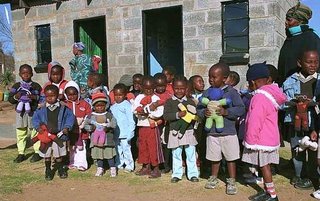Preschool – A patient encounter

“Good morning. How are you doing today, Dear?” I asked.
She looked at me, cocked her head slightly, stood up, and, with light, deliberate steps, followed a horseshoe-shaped course across the exam room until hidden behind her father. She peeked out intermittently to see if I was still looking, but did not reemerge from behind his thin frame. That is, until just before I told her the news.
I redirected my question.
“How is your daughter doing today, Sir?”
The “Sir” was Labasha’s father, a dignified man wearing worn blue coveralls, the uniform of one who labors outside. In response to my question, he raised his eyebrows, put his weathered hands together in front of him, lifted his chin slightly, and asked, “How is my daughter doing today?”
I had always been taught to open a patient interview with a pleasant greeting and an open-ended question. It didn’t always work, and I was zero for two.
In my lap was a thick chart labeled with the name “Labasha Kunene”. A small square of laminated paper with the number “1” on it was paper-clipped to the corner. Mr. Kunene and Labasha had been the first to check in early that morning.
“Let me have a look.”
I opened the manila cover and scanned the note from the previous visit two weeks prior, which explained that Labasha was to return to the clinic today to receive lab results, specifically her latest CD4 count. That explained the girl’s trepidation (recent needle stick) and the father’s reflexive question (wanted the count).
So far, so good.
I looked up, seeking reassurance that I could continue my chart review. The dignified man in blue squinted and smiled. I took the squint to mean that he was anxious to have his answer. The smile told me that he was not irritated at my not telling him outright.
His calloused hands were resting gently in his lap.
I turned back to the very beginning of Labasha’s clinical course. Flipping through the patient’s previous notes, I noticed that Mr. Kunene had never missed one of his daughter’s appointments.
I noticed other things as well.
Labasha had been infected with HIV at birth, approximately 4 ½ years before my arrival in Swaziland. I was in North Carolina attending medical school at the time she became HIV positive.
Labasha had first entered the doors of our clinic a week or so after the clinic’s opening in February, 2006, four months before I would finish pediatrics residency in San Francisco.
When she first arrived at the clinic, she had been suffering from one opportunistic infection after another.
Opportunistic infections have sinister, complicated names, and so physicians scrawl acronyms like TB, LIP, PCP, CMV, and MAC. Even the group of diseases is referred to as “OI’s”.
The chart in my hands was an alphabet soup.
In children infected with HIV, OI’s represent the lapse of the body’s ability to protect itself, the impending demise of the last of the CD4 cells. Specifically, they represent the immunological countdown to the death of Labasha Kunene.
I perused the forms representing Labasha’s three required pre-treatment adherence counseling sessions, where the father expressed adequate understanding of HIV and antiretrovirals. This included the possibility that Labasha would experience “immune reconstitution syndrome” and become more sick (high fevers, respiratory distress, diarrhea, rash, neurological changes, death) when her immune system began to invigorate and fight the many infections currently unchallenged by her crippled defenses.
I noted the signed adherence contract, confirmation that the father was willing to take responsibility for the therapy and to ensure that all of Labasha’s medicines were taken as prescribed.
On the following page, I read the words, “Plan to begin HAART”. With this phrase, Labasha was committed to take three-drug highly active antiretroviral therapy twice daily for life. This was six months ago.
The next pages contained adherence tables, and on those tables were numbers like: 98%, 100%, 97%. These estimate Labashas’s track record of taking the medicines as indicated, calculated by measuring the amount of HAART medication left at each return visit and comparing that to the amount expected if all doses were given correctly. If a patient receives less than 95% of prescribed doses, the patient is highly susceptible to developing resistant virus. The father-daughter duo was missing an average of one dose every month, an excellent achievement.
I continued reading, reaching the first page of lab results.
I hid my reaction as well as I could when I saw Labasha’s CD4 count of <100. This was very low for her age, or for that matter any age. My mind raced as I tried to figure out what this meant. She had been on the medicines for half a year, was taking them as far as we could tell, and was clinically improved. Why were her CD4 cells not responding?
I shifted in my chair, flashed an upward glance. Labasha’s father was still squinting, hands folded. I have often wondered why time slows at certain important instances in life.
As a physician, I have been taught that this has to do with specific hormones, the “fight or flight” response, and such. In this fashion, your body gives you time to take important, potentially life-saving action when time to do so is short.
Well, time slowed at that moment, but a life was not being saved, and I was not certain what to do next despite the prolonged intervening seconds.
Mr. Kunene blinked, his eyelids slowly coming together over his dark brown eyes, and returned to their narrowed position, which grew narrower as he watched me pause. Perhaps he could read me. Perhaps the seconds ticked away slowly for him as well.
Mr. Kunene had arrived at our clinic around half past six that morning so that he could be the first in line and thus find out sooner what his daughter’s CD4 count was. He had traveled from who knows where to get to the clinic. The journey from Swaziland’s rural areas can take several hours. He had dutifully attended a dozen appointments over the last seven months to ensure that Labasha recovered enough CD4 cells to survive childhood.
Before that, he had spent nearly five years watching a healthy-looking baby deteriorate into a thin, sallow child, all the while being pummeled by sicknesses with fancy abbreviations.
A father’s hell.
After so many visits, was I to be the one to tell him that his daughter’s immune system had not improved? Delivering such news is a dreadful part of a pediatrician’s job.
I scanned the page to be sure, and time sped up again. The lab form in front of me was misplaced, and this particular value was from a few weeks before Lambasha started antiretroviral therapy. A simple, very anxiety-provoking clerical mistake. My impulse was to find the culprit and hug him.
I hurriedly turned the last few pages of Labasha's medical biography. On the final page, I saw the new lab report form. I saw the number of CD4 cells that Labasha’s blood contained after 6 months of HAART.
I closed the chart, breathed in as one does before speaking, and looked up.
Instead of meeting the eyes of Mr. Kunene, I met those of Labasha, who was no longer hiding. She was standing directly in front of her father. Her posture was perfect, her chin high. Her mouth wore a subtle grin. I do not know why Labasha placed herself there. Children her age are not entirely predictable. I was glad she was less afraid of me. Perhaps she was merely growing bored.
Nonetheless, as I looked at her, I thought briefly of a photo taken by my father on my first day of kindergarten. I was standing as this young girl was, with the same tepid grin, while the family dog sniffed my lunchbox. I remember nearly nothing from that day, except that it was a very important day and that I was scared.
I wondered if Labasha would be scared on that first day of school, having endured so much suffering.
I looked into the child’s deep brown eyes.
“Hello, Dear, how are you?”
“I am fine.”
“I am Dr. Ryan, and I have very good news.”
I told her that her “soldier cells” had become much stronger. That they were going to keep her from getting sick like she used to. I told her how proud I was to be the one to tell her. I told her how proud I was of her taking all her medicines. I told her how proud I was that she was so brave, that I wished I were so brave.
Labasha’s grin became less subtle, and she turned around as she did not know what to say. Mr. Kunene’s deep brown eyes were more relaxed now. They glistened slightly, as a father’s eyes sometimes do.

Labels: Patient encounters


0 Comments:
Post a Comment
<< Home